|
|
| . |
|
|
|
|
| . |
|
|
List of topics in Section D
| Domain Names
we will discuss these topics in 802d.htm
the strategy of holding certain names |
these topics
are discussed in 719c.htm
|
.
 |
In addition to
our regular textbook and online links for sections that we go through in
IEC 802, we particularly recommend this book Brand Building by Martin
Lindstrom and Tim Frank Andersen. While we recognize that purchasing additional
books is expensive, this particular book is very good and contains good
chapters on all the key areas of branding and traffic building. The book
was published in March 2000 and Amazon just began listing is August 25th,
2000. Amazon
had it for $24 USD
ISBN 0-749433-13-2 310pages, soft cover |
| . | Promotion
in conventional marketing terms means
In IEC 802 we will introduce a concept in the world of online marketing which many might agree to, but few follow. promotion
= communication
To be successful in attracting traffic, using a good domain name and brand building, you need to be more effective at hearing what the customer wants. WTGR |
| Marketing
fundamentals
and,, Marketing
|
Marketing,
a discussion in class about the various terms
marketing, promotion, advertising, selling, providing information - for a ppt presentation covering some of these terms, view - What is marketing , Marketing, the formal definition , Why you should know about marketing (selection of ppt screens from MRK 106, Chpt 1) - the different terms
explained promotion, selling,
advertising, publicity, sales promotion
- discuss on-line article by Jared Spool about good points and bad points of trying to create an emotional bond with customers by using pictures of people using their products. This article was suggested by Phil Nicholls. |
| Jan
30 |
Chapter
9
Traffic and Brand Building 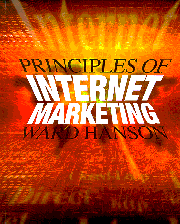 |
- the value a brand has - from existing products (sold in a "brick" situation) now being sold on WWW - for new products with no "brick" presence Brand Association - the favourable relationship marketing people hope becomes established with a product, eg. Nike-Jordan,
|
| Jan
30 |
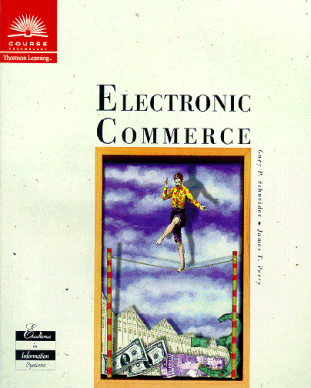 |
In the chapter 8 titled
Strategies for Marketing, Sales, and Promotion there is a section beginning onpage 263 (also on the web site) titled Creating and Maintaining Brands on the Web see http://www.course.com/downloads/sites/ecommerce/ch08main.html in the book, cover the sections on
- read article about building brand awareness on Net Merits of Trying E-Com |
| Jan
30 |
Chapter
3
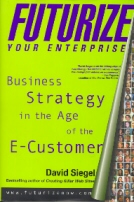 |
In Chapter 3 of David Siegel's
book, he makes the important
point on page 31 that
"... in Internet time, brands are less sticky than you might think. It takes more effort to maintain an online brand than an offline brand" Siegel cautions that in the "customer-led future, company brands will weaken significantly because companies will be pulled apart by their customer divisions, they should plan on restructuring and promoting product or even division brands" well, in several cases, this
is indeed already true among several consumer product companies. Toyota
promotes the Lexus brand as a distinct luxury brand to disassociate itself
from the mass market low price appeal of the average Toyota line-up
|
| Jan
31 |
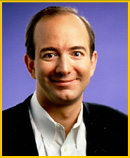 |
In class Jan 31st, we watched
a video which was a biography of Amazon.com founder Jeff Bezos.
The purpose of the video was
Toys R Us
. |
| Feb
6th |
 |

Let's look at what the irreverent people at the Motley Fool.com site have to say about the future directions of Bezos and Amazon.com http://www.fool.com/news/2000/amzn001009.htm In an October 2000 article
on Fool.com, staff writers suggested
"Amazon.com was criticized last week [Oct 2000] for over-expanding its product offerings. Today, Amazon's Chairman and Chief Executive Officer Jeff Bezos answered the charges, and said his company intends to expand into many more product categories." "In an interview with Reuters, [Oct 2000] Amazon's Chairman and Chief Executive Officer Jeff Bezos said: "We will continue to do deals like the photo deal and we'll also continue to enter new product categories." "This model works," continued Bezos. "Selection is an advantage, not a disadvantage." He went on the say that he was sure his company would be profitable eventually, but wouldn't disclose when that might actually occur." Brian Lund, Co-manager
of the Rule Breaker Portfolio
Paul
Commins, Rule Breaker Portfolio Writer
|
| Feb
6th |
 |
"The Amazon Question: Will
Investors Trade Growth for Profits?"
"News that Amazon.com is slashing 1,300 jobs continued to rattle the e-commerce world Wednesday, as analysts said reduced sales forecasts from the bellweather company are a signal that the era of spectacular growth may have ended for the e-tail sector. Amazon chief executive officer Jeff Bezos and other executives blamed a cooling U.S. economy for the slowing sales. However, analysts said the more likely culprit is the company's core business in books, music and videos, which has matured to a point where earlier growth rates are no longer possible." |
| Feb
6th |

|
When you become a celebrity,
whether it be in government, sports, entertainment or business [and Jeff
Bezos has definitely become a celebrity] people will want to stick in their
"two cents worth" and give you unsolicited advice.
Read the humorous, and inciteful
article by Sean Carton
"Hello! Earth to Bezos! What the hell are you doing? You've built a great company based on the premise that stellar service, a great brand experience, and judicious application of your users' information can make an incredible site that millions of us can't do without. In a world where commodity-based dot-coms die out faster than gnats around a bug-light, you've figured out how to stand out from the crowd, sell kajillions of books, and inspire customer loyalty just this side of fanaticism. And you did it all by creating a system that gathers some basic preference information from us, puts it together with information about our basic shopping habits, and then combines it with the behavior of all other users in order to help us loyal customers find new products that consistently delight and inform us. You've even taken the rarely heard customer's voice and incorporated it into the site, allowing customers to see what other people like and don't like in order to make better buying decisions. The result? The dot-com poster-child that the rest of us mere mortals can only aspire to. And now you're throwing it all away." Carton's ponts are based
on the fact that Amazon.com made a point of collecting info from the customer
to allow them to to better satisfy customer interests during repeat visits
to the site - yet the good will created by that might be lost of Amazon
goes ahead and starts sharing that private profile info with othe Amazon.com
group member companies.
An interesting "unflattering" article about a speech Bezos gave. The writer mentions Amazon.com's patents. http://www.holtuncensored.com/members/column157.html "Amazon.com's two controversial
software patents - one of which he's used to sue his main competitor,
Barnesandnoble.com. Nor did he mention the latest patent, issued
only days ago for collaborative filtering, a method of sorting millions
of customer preferences electronically to help new customers choose
products and services.
|
|
|
.
| Feb
6th |

Chapter 7 |
chapter 7 Why brand-build
on the Internet
the authors discuss
|
| Feb
6th Feb
Feb
|

Chapter 8 |
chapter 8 Strategic
building up of brands on the Internet
the authors discuss web segmentation
"to date, the most frequently used quantitative measurement of a website's success has been the number of hits... these figures tell us nothing about the actual quality of the website. At a pinch they tell us something about how good the company has been at creating traffic... the quantitative goals should be based on a number of measurable parameters which can describe the quality of the communication on the website ... goals should be set for |
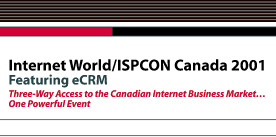
| Class cancelled Feb 7th so IEC students can participate in the Seneca booth at Internet World 2001 |
| Feb
13th |
|
Morris describes the different
types of online advertising - of which online ads are just one component
|
| Feb
13th |
|
This article, which was carried
in The Star Dec 26th, 2000, discussed interstitial ads.
Susan Stellin writes that even of we don't like this, companies will still do it because it seems to be effective. Stellin quotes a number of people in the article that talk about there various experients running interstitial ads and the main point seems to be that you have to focus these on a particular segement and the content within the interstitial ads has to be pretty kewl otherwise people just find it annoying. |
| Feb
13th |
|
Featherly notes that "... Dot-com news, music and entertainments sites have been laying people...a new report by market analysis firm Forrester Research predicts that if such companies can hang on for just two more years, profitability will arrive. And the oldest media revenue source - advertising - once again will step in as the savior." Feathjerly quotes Forrester
media analyst Eric Scheirer
"Says Scheirer, as advertisers continue flocking to the Web to get the word out about their products, they will be forced to compete for many of the same "super-target" online content pages - search-query returns on Yahoo and the shopping-bot results on the MySimon.com site are two examples. But not all advertisers will be able to schedule ad appearances on those pages, nor will they wish to pay the high price those ad slots will fetch, according to the Forrester report. Instead, the study says, the trickling will begin. Just below the "super-target" site grade lies what Scheirer labels "premium" site pages, well-contextualized pages of content designed to work with targeted ads" "There is no doubt, the analyst says, that the current picture is bleak, and that many online publishers could be convinced to throw in the towel now....But patience will bear fruit, the analyst insists." |
| Feb
13th |
|
This article is in five parts:
Morris says "Online advertising is in fact an easy thing to measure and quantify. The Internet can provide a level of detail that no other medium can ever hope to. The online advertising business is a more mature one than many people realize, and the tools to measure the effectiveness of banner ad campaigns are there for those who know how to use them." "Banner ads, as far as we're concerned, are sold by the page impression - each time a user views one Web page is counted as one impression. Prices are quoted in "CPM", a holdover from print ad days which means "cost per thousand". For example, if the CPM for a particular campaign is $20, then it would cost $2,000 for 100,000 impressions." Morris explains "Banner ads yield two benefits. First, they may entice users to click on the banner and go to the advertiser's site. Each time this happens is called a "clickthrough", and the number of clickthroughs divided by the number of impressions is called the "clickthrough ratio" or "click rate". This is easy to measure, and provides a direct measurement of a banner's effectiveness. The second benefit of ad banners is building brand recognition. Despite ad agency claims to the contrary, this is almost impossible to measure." |
| Feb
13th |
|
Morris begins by stating that "thanks to the huge number of ad networks and affiliate programs out there, practically any Web site, no matter how small, can sell advertising. Thanks to the lubrication of computer networks, the world economy has reached a point at which you can buy or sell almost anything in any quantity, large or small." The reason that it is helpful to look at this particular article by Morris, is because of the useful list he compiles of the downsides to having ads on your site. Morris says "the tiny amount
of cash you would receive from selling ads isn't worth the drawbacks"
|
.
Establishing Brand Presence
|
.
| Feb
14th Feb
Feb
|

Chapter 10 |
Chapter 10 "Online Communities
- the virtual marketplaces of the future"
"Why communities are so interesting to companies" page 203-205
Eg. you wouldn't sell a Harley Davidson motorcycle on the Harley site, but you do have a selection of clothing and relatively inexpensive accessory items which you can buy. http://roadstore.harley-davidson.com 
The Harley site, like many up and coming corporate web sites, is endeavouring to track visitors and collect demographic information by inviting frequent visitors to the page to sign up and login for access to special features. By offering rewards to regular visitors to the site, Harley is building loyalty and also increasing the opportunities to upsell and cross sell within the range of accessory items online. |
| Examples of companies trying to develop "product evangelism" by creating a community around the brand and other "especially innovative and exciting" situations | Beverage companies do not sell beer, ice tea and cola on the net, why do they have web sites and what do they use them for? |

|
http://www.snapple.com/home.html
Snapple, in trying to compete against the Cola giants, Pepsi and Coke is trying to use their web site and other promotion to turn customers who are at the brand insistence stage into "evangelists". The point being not only will these people be faithful drinkers of the beverage line, but that they will be "fans" and encourage other people to drink the products. How do you facilitate their development of fan status - by giving them kewl screen savers, let them order merchandize with the logo, win prizes, enter contest etc. Snapple can also use the online site to gather specific name and address information of loyal customers which they will use in "direct mail" campaigns in ensure |

|
In April of 2000, Molson's
got much more reaction than it expected when it launched its TV commercial
"I Am Canadian".
The web site www.iam.ca on which the commercial is downloadable became, according to some accounts, the number #1 downloaded feature on the web for Canadian surfers in the spring of 2000. At the I AM website,
The questionnaire which you
fill out to get the free email includes the statement
Such customer profiling techniques were done by the American cigarette companies in the 1980's in order to develop long-term brand insistence - however it was expensive to do that then due to the amount of free merchandize you had to give away - "kewl" web sites allow this customer profiling to be less costly and you can create communities of customers that in turn create a dynamic that can be very exciting The National Post picked
up on this story of Molson and their I AM CANADIAN ad and accompanying
web site and ran a story by Jonathon Gatehouse on the patriotic fervor
created
|

|
Not to be outdone, Labatt's
page www.labatts.com
is also pretty kewl and has a link to the (now famous) beer.com site
incidentally, did you know beer.com was done by Transfer interrupted! |
| Feb
14th Feb
Feb
|
Domain
Names |
Domain Names (a new definition of "place") http://www.GreatDomains.com/valuation.asp "Ultimately, the value of a domain name is driven by its ability to deliver traffic and revenue to a business. This determines how much a company would pay for a domain name" If the name you want is already
taken as a domain, think of a solution name that people can remember, such
as www.earache.comif you're
into noise.
People making money selling
domain names
|
||||
| Feb
14th Feb
|
Domain
Names . the "new" names  |
applies to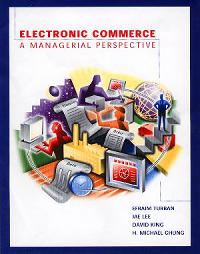 Chapter
10, page 356 Chapter
10, page 356
NSI - Network Solutions
Inc.
In July 2000 The Globe and Mail was one of several newspapers reporting on the story about the World Wide Web using new suffixes that may include .shop, .tel and .news. The Globe's story (which
came of the Reuter's wire) can be found at
Essentially the situation
is this:
"Deadline's Counting Down on .ca Domains" is the title of Toronto Star writer Rachel Ross' Sept 18th, 2000 article Ross warns that "90,000 registered .ca domains have six weeks, beginning Sept 18th to re-register Canadian domain names with the new authorities, or risk deactivation". FYI newsbytes.com says that
only 5,000 dot.ca names are effected
additional information on
the 5,000 effected
In the past, Canadians wanting to register a .ca name had (typically Canadian) a lot of rules and regulations. As a result, 80% of the registrations Canadians were taking out were going to the .com space - which is "money going out of the country" said the president of Tucosws (which also does registrations). |
| Feb
14th Feb
|
Domain
Names the
Domain
the
|
Osler Hoskins, a
well known old Canadian law firm has a small section on their web site
advising readers about the .ca changes and making the point that Oslers
has experience dealing in the legal aspects.
www.osler.com/publications/NorthSouth/#ecom Law firm of Bereskin and Parr, 150 lawyers + the largest intellectual property specialty firm in Toronto. www.bereskinparr.com/precis/precis9907.html The Current Rules (from Bereskin and Parr's website) "Under the current Canadian
system, a company name is limited to one domain
name
The Proposed Rules (from Bereskin and Parr's website) "The proposed system will permit Canadian companies and Canadian individuals to register as many domain names as they wish, and there will be no specific restrictions with respect to the granting of the domain names. The proposed rules will remove the essentially "one domain per organization" rule and introduce a "first-come first-served" system which will no longer require evidence of entitlement to a proposed domain name (i.e. by providing proof that the proposed domain name is a corporate/business name or a trade mark). While the proposed rules explicitly restrict eligibility to Canadian parties (the rules state that "registrants must be Canadian citizens, residents, companies or other legal entities"), CIRA is considering a proposal from the Patent and Trademark Institute of Canada that would provide a two month transition period during which all owners of Canadian registered marks, ostensibly both Canadian and non-Canadian, would be able to register their marks as .ca domain names. It is suggested that during this period a "stop list" of Canadian trade mark registrations and official marks would be maintained so as to prevent any party but the trade mark owner from registering them as .ca domain names. The stated purpose of the proposed transition period would be to prevent cyber-squatters from obtaining domain names containing registered trade marks." |
| Domain
Registration |
Robert Hall is owner of
Internic.ca which allows companies to register domains as .ca or .com.
Hall says many good .ca names are free and weren't taken because of the
longer regulations to register them. Hall's people at Internic.ca are allowing
people to pre-book new .ca names when the system gets opened up in November.
 www.internic.ca www.internic.ca
The FAQ on Internic.ca's site is helpful, for more information, go to http://www.internic.ca/transfer/faq.asp#1 |
| The Canadian Internet
Registration Authority
this organization is the not-for-profit organization mandated to operate the .ca domain. contact at CIRA is
|
|
| Domain
Registration "who is" |
www.networksolutions.com/cgi-bin/whois/whois on Network Solutions' page (also a domain name registrant) you can check to see who is the owner of a particular name (internic.ca has the same feature on their site).
+, if you do not want to
be "found" in whois, you can registrar your domain name privately,
this is used when people want to avoide dealing with cybersquatters
|
| Feb
14 Feb
|
Domain
Names . the strategy of holding certain names |
Not everybody is trying
to obtain all the names relevant to their business and hoard this for future
use. A Reuters story in the summer of 2000 noted that giant consumer products
company, Procter & Gamble had decided
to sell off some names they were no longer going to use and P&G was
going to sell these names through an auction process to the highest bidder.
Some examples of the names
they were selling were
read the press
release from P&G's website about their domain name selloff
The sell off by P&G represents
perhaps, a maturity in thinking about domain names - that being the understanding
that people are not stupid when they search for information on the net;
they don't type in flu.com and expect all the answers to be there. However,
in the beginning of the gold rush to secure rights to domains, it was considered
critical to "collect" all the ones relevant to your business.
Interestingly, a Dr. Proctor, who spells his name slightly differently, owns the domain www.proctorandgamble.com and on his sight makes comment about how procterandgamble.com poached a large number of domain names many years ago - but they forgot about misspellings !! For a very interesting perspective
on P&G's collection of names, read the critique at
|